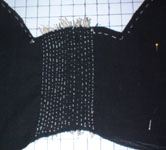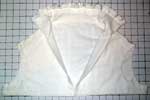| Lorenzo's Progress Log |
This is where I keep track of my sewing projects. Feel free to email me with any comments or questions.
| Sep 22, 2005 |
| ... | |
|
A short post-holiday note: covering stretchy linen with stretchy cotton is a recipe for madness. |
|
| category: /flemish/woman | permanent link | |
| Cording Complete | |
|
The cording is done, and both pieces have gone through the washer and drier unharmed. It's hard to find time to do another fitting, so I've been doing some unnecessary quilting on the back and reinforcing the back edges of the lacing with cord and heavy wool strips in preparation for putting in eyelets. I also noticed (a little late, perhaps) that the lacing edges for the front and back are nowhere near the same length. Fortunately I'm not so committed that I can't change the shape of the front piece to make everything fit. |
|
| category: /flemish/woman | permanent link | |
| More Cording | |
|
I've finished the cording across the front. It extends to the far edges of the shoulder straps at the top, and narrows toward the waist. I'm going to add two more sections at the sides, but I don't plan to do any stiffening in the back. I may put a cord near the lacing holes, but that's all. Once I get the front and sides done I'll try it on again and see if it's working the way I want. I also will probably narrow the straps after the next fitting. The front section (~50 channels) only took a couple nights of sewing. Not as bad as I thought it would be. |
|
| category: /flemish/woman | permanent link | |
| Corded Kirtle Bodice | |
 I finally got a chance to start patterning the kirtle. I decided to start with the wedding dress pattern and alter it, which means that I'm doing side back lacing after all. I'm making the foundation of the bodice out of black cotton/linen. The heaviest hemp cord available at the local craft store was 48# (much lighter than the 170# cord used by others), so I was worried that it wouldn't work right. As it turns out, the lighter cord is working very nicely. I'm using two lengths per channel (doubled, so there are four cords total per channel), and it provides ample support. The threading tool I'm using probably wouldn't fit a larger cord, so it's just as well I couldn't find anything larger. Even sewing the channels by hand, it's really not taking nearly as long as I thought it would. I finally got a chance to start patterning the kirtle. I decided to start with the wedding dress pattern and alter it, which means that I'm doing side back lacing after all. I'm making the foundation of the bodice out of black cotton/linen. The heaviest hemp cord available at the local craft store was 48# (much lighter than the 170# cord used by others), so I was worried that it wouldn't work right. As it turns out, the lighter cord is working very nicely. I'm using two lengths per channel (doubled, so there are four cords total per channel), and it provides ample support. The threading tool I'm using probably wouldn't fit a larger cord, so it's just as well I couldn't find anything larger. Even sewing the channels by hand, it's really not taking nearly as long as I thought it would.I also stole another of Jen's ideas and made a set of temporary lacing strips, which are a great help for intermediate fittings. I was feeling lazy, so I just sewed rings onto strips of wool. I made them a little too short, so I need to make another set that are a little longer. |
|
| category: /flemish/woman | permanent link | |
| Swatches And Sketches | |
  After washing, I'm pretty sure the brown cotton is darker than it was before. I didn't save any to compare, so I might just be imagining things. At any rate, these are the materials I have picked out so far. Here's an updated sketch using the swatch colors. After washing, I'm pretty sure the brown cotton is darker than it was before. I didn't save any to compare, so I might just be imagining things. At any rate, these are the materials I have picked out so far. Here's an updated sketch using the swatch colors. |
|
| category: /flemish/woman | permanent link | |
| Beginnings: Flemish Working Woman's Dress | |
|
My wife isn't as excited about wearing experimental clothes as I am, so I decided to make her something that's been thoroughly tested by others. First let me give all due credit to Drea Leed and Jen Thompson for their work both in research and reconstruction of this style of dress. I don't expect to add much to the existing body of knowledge with this project, but I figured it couldn't hurt to document it. The dress is still in the planning stages, but it's a pretty firm plan. Here's a sketch of the color scheme I have in mind. I already have some of the material picked out, a lightweight blue cotton for the kirtle and a fairly heavy brown cotton for the gown. Both are very soft. I'm being good and actually pre-washing them both as I write this. I don't have anything picked out for the gown lining yet, and I may change the color if I find something I really like. The sketch shows guards on the kirtle, even though I haven't noticed any in any of the paintings of this style. I may or may not put them on, but I wanted to see how it would look. I plan to do a rectangular pleated skirt on the kirtle, and a gored skirt on the gown. I also intend to use another bit of Jen's research and stiffen the kirtle bodice with hemp cord. Ideally it will be useable under other gowns as well. The kirtle will most likely lace up the back. I usually avoid back lacing because it's impossible for the wearer to put on solo and I personally think it's unattractive. However, I generally tend to do all the lacing myself anyway, and since it's a kirtle, the lacing will always be covered by another gown. The upside is that it should cut down on the number of eyelets I have to put in. I'll probably engineer a fairly large gap in the back to allow for some fluctuation in size. Again, it should all be covered so no one will see it. I'll also line up the skirt seams with the side seams of the bodice in case I have to take drastic measures in the future and put in side lacing as well. I'm worried that if I have to lace it tighter in the back it'll throw off the shoulders too much. Since there are no sleeves it shouldn't be a very big problem but I want to be prepared. Also in the plan are the necessary underpinnings and accessories: a smock (cotton, sadly), a light partlet (again, plain old cotton, but the partlets don't seem to be terribly sheer so I won't feel too bad), a heavy partlet (I found some black wool this morning that should be perfect), sleeves, a cap, and an apron. I'm very excited about this project. It's a very versatile dress, and seems perfect for dealing with a small child with a minimum of difficulty. |
|
| category: /flemish/woman | permanent link | |
| The Other Partlet | |
 Since the weather's warmed up I needed to make the other partlet for the Flemish dress. It's not the finest material in the world, but it was free. I experimented with stiffening the edge of the ruff with cotton yarn. We'll see how it looks when it's worn. I found out too late that I'm out of silver hooks and eyes, so this weekend I'll probably just pin it at the front. Since the weather's warmed up I needed to make the other partlet for the Flemish dress. It's not the finest material in the world, but it was free. I experimented with stiffening the edge of the ruff with cotton yarn. We'll see how it looks when it's worn. I found out too late that I'm out of silver hooks and eyes, so this weekend I'll probably just pin it at the front.
|
|
| category: /flemish/woman | permanent link | |
| Pictures! | |
| I finally got a chance to put everything together. I think the partlet is a little wide in front, and the gown needs a touch more shaping at the back neckline, but I can fix both pretty easily. I converted a dish towel into a quick apron, et voila: | |
| category: /flemish/woman | permanent link | |
| Field Test | |
|
The dress weathered its first event well. There's another picture here. I've been informed that I need to make her another kirtle in addition to the other gowns I had planned to make. I should also make a few more smocks. A friend of mine was interested in having me put together one for her as well. Plus there are a few other projects that people would like me to take on. It looks like I'll have a lot to do, which means that I'm going to have to bite the bullet and break out the sewing machine again. I'll still do all the finishing work by hand, but I just can't make everything I need to make fast enough without cheating some. I'm going to keep myself pure for my own clothes, however. If nothing else, hand sewing makes it much easier to avoid screw-ups while working out a new pattern. It keeps my sewing from outpacing my thinking, which is a good thing. |
|
| category: /flemish/woman | permanent link | |
| Partlet Madness | |
| I cut out the partlet last night and got the back half put together. The shell is a lightweight black wool reclaimed from a half-finished cloak. The interlining is a coarsely woven springy tan wool that I've been using up a little bit at a time for years and years. The point at the back of the partlet looked like it wanted to flip up, so I put a coupole of fender washers inside before sewing it up. I will hopefully finish it tonight and get some pictures taken. | |
| category: /flemish/woman | permanent link | |
